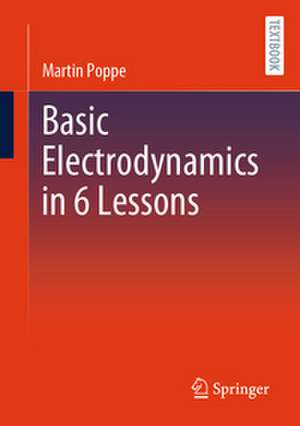Basic Electrodynamics in 6 Lessons
Autor Martin Poppeen Limba Engleză Paperback – 28 sep 2024
Preț: 383.12 lei
Nou
Puncte Express: 575
Preț estimativ în valută:
73.33€ • 79.68$ • 61.64£
73.33€ • 79.68$ • 61.64£
Carte disponibilă
Livrare economică 31 martie-14 aprilie
Preluare comenzi: 021 569.72.76
Specificații
ISBN-13: 9783662691427
ISBN-10: 3662691426
Pagini: 200
Ilustrații: Approx. 200 p.
Dimensiuni: 148 x 210 mm
Greutate: 0.3 kg
Ediția:2024
Editura: Springer Berlin, Heidelberg
Colecția Springer
Locul publicării:Berlin, Heidelberg, Germany
ISBN-10: 3662691426
Pagini: 200
Ilustrații: Approx. 200 p.
Dimensiuni: 148 x 210 mm
Greutate: 0.3 kg
Ediția:2024
Editura: Springer Berlin, Heidelberg
Colecția Springer
Locul publicării:Berlin, Heidelberg, Germany
Cuprins
- Classical Electrodynamics in Modern Times.- Charge and Current.- Maxwell’s Equations.- Static Electric Fields.- Static Magnetic Fields.- Time-Dependent Fields.
Notă biografică
Martin Poppe received his doctorate in Physics from the University of Oxford in 1981. At DESY, he developed the formal foundations of matter generation from colliding virtual photons. The results were published and cited more than eighty times in thirty years. After working at CERN and Bosch, he joined Muenster University of Applied Sciences, where he taught electrical and electronic engineering. He is (co-) author of several textbooks, including "Springer Handbook of Mechanical Engineering".
Textul de pe ultima copertă
This book explains why there are different variants of Maxwell's equations, and it describes the physical meaning of the quantities they contain. It also shows how the equations for static electric and magnetic potentials are derived from Maxwell's equations. Matter exposed to the fields is an integral part of the discussion. Multipole developments are justified and derived. Furthermore, the potential for simplifications in formulating the dynamical theory as a gauge field theory is explained. The laws of optics are derived from those of electrodynamics. Justifications are provided for quasi-stationary calculations, limits are formulated, and technical examples and counterexamples are shown.
Content
Classical Electrodynamics in Modern Times – Charge and Current – Maxwell’s Equations – Static Electric Fields – Static Magnetic Fields – Time-Dependent Fields
Target Group
Engineers, physicists, and graduate students in Physics and Electrical Engineering
The author
Martin Poppe received his doctorate in Physics from the University of Oxford in 1981. At DESY, he developed the formal foundations of matter generation from colliding virtual photons. The results were published and cited more than eighty times in thirty years. After working at CERN and Bosch, he joined Muenster University of Applied Sciences, where he taught electrical and electronic engineering. He is (co-) author of several textbooks, including "Springer Handbook of Mechanical Engineering".
Content
Classical Electrodynamics in Modern Times – Charge and Current – Maxwell’s Equations – Static Electric Fields – Static Magnetic Fields – Time-Dependent Fields
Target Group
Engineers, physicists, and graduate students in Physics and Electrical Engineering
The author
Martin Poppe received his doctorate in Physics from the University of Oxford in 1981. At DESY, he developed the formal foundations of matter generation from colliding virtual photons. The results were published and cited more than eighty times in thirty years. After working at CERN and Bosch, he joined Muenster University of Applied Sciences, where he taught electrical and electronic engineering. He is (co-) author of several textbooks, including "Springer Handbook of Mechanical Engineering".
Caracteristici
Maxwell's equations in matter” are derived from those without matter and thus proven to be non-fundamental The quantity H is shown to be the fraction of the magnetic field that can be attributed to free currents The book explains why dipole densities can be added to electric fields - in contrast to pears and apples
